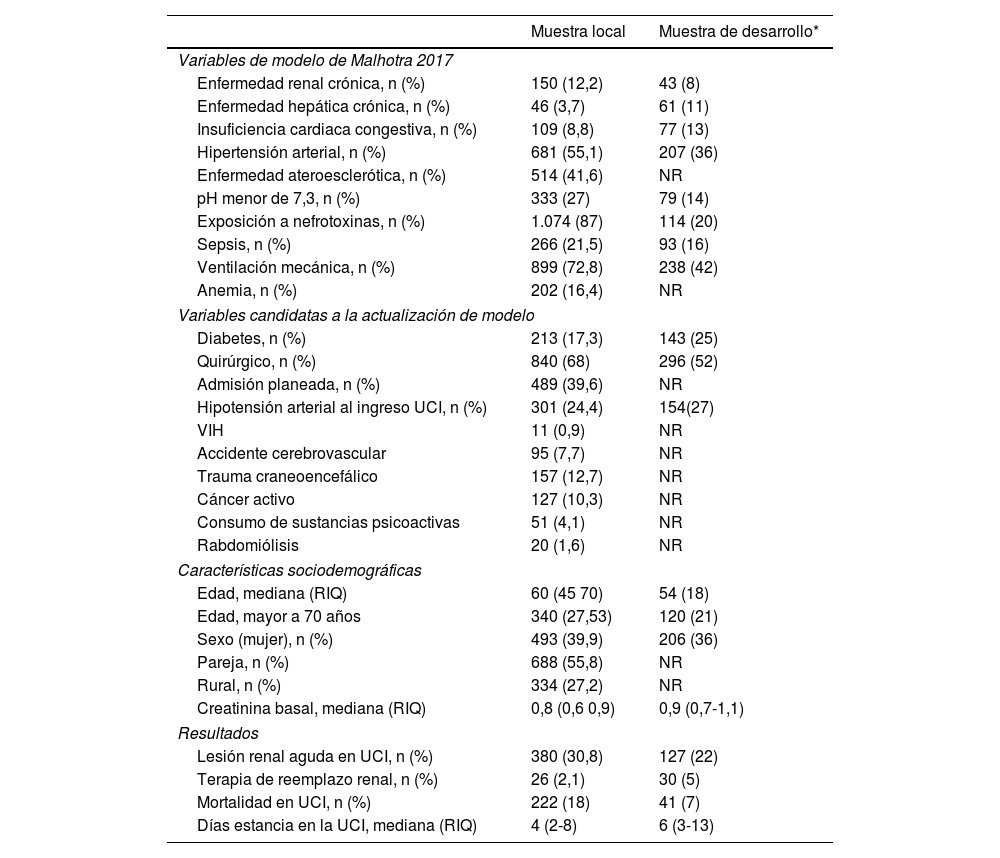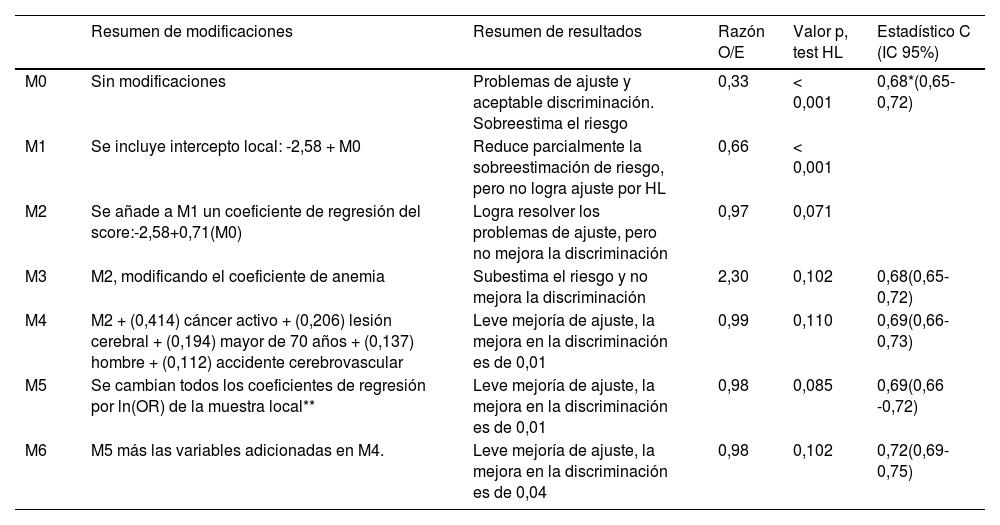Analizar el desempeño predictivo del modelo de riesgo de lesión renal aguda (LRA) de Malhotra et al., en adultos hospitalizados en la unidad de cuidados intensivos (UCI) de la Clínica Somer (Colombia), 2017 y 2021.
MétodosEstudio retrospectivo de seguimiento a una cohorte basado en registros médicos. Se incluyeron mayores de 18 años críticamente enfermos ingresados a UCI. Se excluyeron pacientes con enfermedad renal crónica terminal o en terapia de reemplazo renal, LRA al ingreso. Como variable de resultado se definió LRA en la primera semana en UCI, y como variables predictoras las del modelo de Malhotra y variables clínicas adicionales. El desempeño predictivo se analizó para los modelos original (m0), calibrado (m1-m2) y actualizado (m3-m6) mediante estadístico C, prueba de Hosmer-Lemeshow (HL) y mapas de calibración.
ResultadosSe incluyeron 1.235 pacientes, edad mediana de 60 años (RIQ 45-60), 39,9% mujeres. La incidencia de LRA fue de 30,6%. El modelo original (m0) mostró problemas de ajuste (valor p HL < 0,05) sobreestimando el riesgo de LRA y obtuvo un estadístico C de 0,68 (IC 95% 0,65 – 0,71). La calibración mediante intercepto y factor global (m2) resolvió el problema de ajuste. La actualización con 10 variables adicionales (m6) solo aumentó el estadístico C a 0,72 (IC 95% 0,69 – 0,75).
ConclusiónEl desempeño del modelo original en la cohorte de validación externa no es perfecto debido a diferencias en epidemiología de la LRA en UCI. La actualización del modelo mejora el ajuste más no la discriminación, pero tiene algún grado de utilidad en la práctica clínica.
To analyze the predictive performance of the risk model for acute kidney injury (AKI) by Malhotra et al., in adults hospitalized in the intensive care unit (ICU) of Clínica Somer (Colombia), 2017 and 2021.
MethodsRetrospective follow-up study of a cohort based on medical records. Critically ill patients over 18 years of age admitted to the ICU were included. Patients with end-stage chronic kidney disease or on renal replacement therapy, AKI at admission were excluded. AKI in the first week in the ICU was defined as the outcome variable, and those of the Malhotra model and additional clinical variables as predictor variables. The predictive performance was analyzed for the original (m0), calibrated (m1–m2) and updated (m3–m6) models using the C statistic, the Hosmer–Lemeshow (HL) test, and calibration maps.
ResultsA total of 1235 patients were included, median age 60 years (IQR 45–60), 39.9% women. The incidence of AKI was 30.6%. The original model (m0) showed fit problems (p-HL value <0.05) overestimating the risk of AKI and obtained a C statistic of 0.68 (95% CI: 0.65–0.71). Calibration using intercept and global factor (m2) solved the adjustment problem. The update with ten additional variables (m6) only increased the C statistic to 0.72 (95% CI: 0.69–0.75).
ConclusionThe performance of the original model in the external validation cohort is not perfect due to differences in the epidemiology of AKI in the ICU. The model updated improves the fit but not the discrimination, yet it still holds some degree of utility in clinical practice.
Artículo
Socios de la Asociación de Medicina Crítica y Cuidado Intensivo
Para acceder a la revista
Es necesario que lo haga desde la zona privada de la web de la AMCI, clique aquí
Comprando el artículo el PDF del mismo podrá ser descargado
Precio 19,34 €
Comprar ahora














